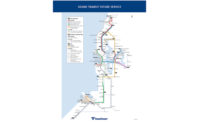Related Links:
Seattle's Link Light Rail - The Start of Something Big
Drilling Crews in Washington Sought Cherries, Got the Pits
The successful completion this spring of twin 2.1-mile-long bored tunnels in Seattle marks a literal breakthrough in that city's troubled history of light-rail construction. It also represents the halfway mark in the 3.15-mile, $1.9-billion project to connect downtown with the University of Washington.
The 21-ft-dia tunnels run between Capitol Hill and the university. A Traylor Bros. Inc. and Kemper-Frontier Constructors Inc. joint venture worked under a $309-million contract.
While previous light-rail projects featured permanently broken tunnel-boring machines (TBM) and sinkholes, the so-called University Link project is about 75% completed and trending to be under budget. "Except for complaints of surface vibrations caused by the supply cars, the tunneling was uneventful," says Joe Gildner, project deputy construction director with the owner, Sound Transit.
The JV undertook several vibration-mitigation efforts, such as installing wooden rail ties in lieu of steel, rubber pads under rail sleepers in certain sections and ground rail joints, says Michael A. Krulc, the contractor's project manager.
The riskiest part of the job was mining under the Montlake Cut, part of a canal built in 1906 to connect Lake Washington with Puget Sound, says Krulc, noting that the tunnel alignments cross only eight feet below the original cut elevation of the ship canal.
Tight Squeeze
A joint venture of Jay Dee Contractors Inc., Frank Coluccio Construction Co. and Michaels Corp. is building one mile of the Capitol Hill-to-downtown tunnel under a $153-million contract.
The alignment crosses just 13.5 ft under Interstate 5 and features a 200-ft vertical drop, a sweeping right-hand turn under the urban grid and S-turns near I-5, says Glen Frank, the joint-venture project manager. Before crews could even think about digging under the roadway, a separate contract included making room for the TBM. Eight-ft-thick steel piles on either side of I-5 "hold up Capitol Hill on one side, and the other wall holds up downtown Seattle," says Sound Transit spokesman Bruce Gray. "We don't want anything to happen to the walls."
A 2010 contract included excavating to the piles and cutting 30-ft-dia holes in the steel, just enough wiggle room for the 21-ft-dia TBM to squeeze through. Tiebacks also anchor the walls. With only two windows on each side of the TBM, crews then backfilled the space with controlled-density fill. "We didn't want the TBM grinding against those steel piles or impacting them," Gray says.
Last year, after the joint venture excavated its first tunnel, the TBM "Brenda" was disassembled at its downtown finish location before being hauled back to the Capitol Hill pit (which will become a new transit station) for reassembly. Now Brenda is working her way back under I-5.
"To complicate matters, the whole area is in a landslide zone, and the whole mass of soil we are tunneling through has all moved in the geological past," Frank says.
In the rest of the project, the team applied enough pressure from the front of the TBM to "have all our bases covered," but that only works with 60 ft of clearance, says Frank. At 13.5 ft, too much pressure will push grout to the road surface. "With such low cover, the ground loses the capacity to hold pressures you need to apply if the ground were to be unstable," Frank says. "At the same time, you can't apply pressure to the ground so that fluids escape up and impact the drivers. You take all your safety factors out."
To combat those factors, crews take real-time pressures using the TBM as a giant gauge. The TBM advances about five feet every 20 minutes and then takes a 25-minute break while a concrete liner ring is built behind it. "By analyzing what the ground does in reaction to your pressurizing, you can actually see how hard the ground is pushing," says Frank.
The Traylor Bros.-Kemper-Frontier team built 20 safety-related cross tunnels by hand under its contract. Jay Dee-Coluccio-Michaels crews are hand-digging five 10-ft-dia cross-passage tunnels.
Extensive monitoring devices are placed on anything that can't move, from utility pipes to buildings to the I-5 roadway, with crews watching continuously for any settlement. "We have had no indication of any settlement at all," Frank says. If things continue to go smoothly, the new University Link will open in 2016.




Post a comment to this article
Report Abusive Comment